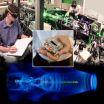(Press-News.org) With adolescents seemingly glued to cell phones and social networking websites, experts are investigating whether the near-constant digital activity changes youths' development.
A new study from the University of Washington shows that digital media helps teens reach developmental milestones, such as fostering a sense of belonging and sharing personal problems. But the study also raised questions about whether digital connectedness might hinder the development of an autonomous sense of self.
Katie Davis, an assistant professor in the Information School and an expert on digital media use during adolescence, calls it "Friendship 2.0."
"What they're doing is different from generations of teenagers from before the digital era, but it comes from the same place of basic developmental needs. It's just that they're using different tools to satisfy these needs," said Davis.
She is the author of a study on the role of digital media in adolescent friendships and sense of identity, an important factor in psychological well-being. The study will be published in the November issue of the Journal of Adolescence.
Davis interviewed 32 adolescents, aged 13 to 18 and about an even mix of boys and girls, living on the island of Bermuda where teens have similar digital media habits as teenagers in the United States. She asked them about how they use media to communicate with friends, and came up with an inventory of their media use:
94 percent have cell phones.
53 percent have Internet-enabled cell phones.
91 percent have Facebook profiles.
78 percent use online instant messaging, such as MSN, AOL or Skype.
94 percent use YouTube.
9 percent use Twitter.
These percentages are similar to what Davis found when she surveyed 2,079 youths living in Bermuda, an affluent British-dependent territory located about 640 miles off the coast of South Carolina. Though more Bermudian teens use social networking sites and own cell phones than American teens, Davis says that her findings from the island where she grew up and worked as a school teacher can provide insights on U.S. teens because the two countries share cultural ties and the role of digital media in teens' lives is similar in both places.
Davis asked about the content of their digital conversations and analyzed 200 examples shared by the teens. Casual chatter about homework or what they did that day occurred three times more than intimate conversations about feelings or problems.
Looking more closely at the casual exchanges, Davis found that friends stay connected through frequent check-ins, sharing something funny that happened or asking what they're up to or how they're doing. These off-the-cuff conversations can last throughout the day, with breaks for going to class or having dinner.
Most – 68 percent – of check-ins occur on Facebook, and include groups of friends commenting on photos or YouTube videos. Nearly half of the participants in the survey talked about posting photos of themselves with their friends and then tagging their friends, allowing them to discuss a shared experience and promote a sense of belonging to a circle of friends.
Intimate exchanges, discussed by 69 percent of participants – usually girls – included how they were feeling, whether they were having a bad day or other problems that they hoped to get their friends' help with. Youths, especially those describing themselves as shy or quiet, said that it was easier to share these personal thoughts digitally than in person. Some felt typing rather than speaking their feelings gave them more control.
Some participants considered the ability to connect anytime and anywhere with their friends to be not just convenient, but necessary to stay up-to-date and to avoid feeling isolated or being left out of group activities.
"Adolescents are interacting with their peers constantly, and the question arises as to whether they can still develop an autonomous sense of self," Davis said. This isn't known yet, but she suspects that this constant connectivity may support the development of an outward-looking self, one that looks to others for affirmation rather relying on an internal sense of worth and efficacy.
"Relying on others for self-affirmation suggests a relatively fragile sense of self, but our study doesn't say for sure that that is what is going on," Davis said. "What we can say is that adolescents are using digital media to promote their sense of belonging and self-disclosure of personal problems, two important peer processes that support identity development."
### The study was funded in part by The Bank of Bermuda Foundation.
For more information, contact Davis at kdavis78@uw.edu or 206-221-7741.
Friendship 2.0: Teens' technology use promotes sense of belonging, identity
2012-10-22
ELSE PRESS RELEASES FROM THIS DATE:
Breast cancer cells enticed to spread by 'tumorous environment' as well as genetic changes
2012-10-22
A new study from Johns Hopkins researchers suggests that the lethal spread of breast cancer is as dependent on a tumor's protein-rich environment as on genetic changes inside tumor cells.
In a report in the Sept. 25 issue of the Proceedings of the National Academy of Sciences, the scientists conclude that a molecular signal in the protein meshwork surrounding the breast cancer cells may provide the critical trigger to initiate the life-threatening process of metastasis to distant sites in the body.
Moreover, their experiments suggest that the environment surrounding ...
Clue to cause of Alzheimer's dementia found in brain samples
2012-10-22
Researchers at Washington University School of Medicine in St. Louis have found a key difference in the brains of people with Alzheimer's disease and those who are cognitively normal but still have brain plaques that characterize this type of dementia.
"There is a very interesting group of people whose thinking and memory are normal, even late in life, yet their brains are full of amyloid beta plaques that appear to be identical to what's seen in Alzheimer's disease," says David L. Brody, MD, PhD, associate professor of neurology. "How this can occur is a tantalizing ...
State-of-the-art beams from table-top accelerators
2012-10-22
Focusing in on beam focus
The rapidly evolving technology of laser plasma accelerators (LPAs) – called "table-top accelerators" because their length can be measured in centimeters instead of kilometers – promises a new breed of machines, far less expensive and with far less impact on the land and the environment than today's conventional accelerators.
Future LPAs offer not only compact high-energy colliders for fundamental physics but diminutive light sources as well. These will probe chemical reactions, from artificial photosynthesis to "green catalysis"; unique biological ...
Scattered X-rays reveal diseased tissue
2012-10-22
This press release is available in German.
Chronic obstructive pulmonary disease (COPD) is considered the fourth most common cause of death in the United States. Usually the precursor to this life-threatening lung disease is a chronic bronchitis. Partially destroyed alveoli and an over-inflation of the lungs, known as emphysema, are serious side effects. However, the subtle differences in the tissue are barely discernable in standard X-ray images.
In addition to the conventional X-ray images, the Munich scientists analyzed the radiation scattered by the tissue. ...
Fewer patient deaths after surgery in hospitals known for good nursing care
2012-10-22
Patients treated in magnet hospitals (specially designated for their nursing excellence) had 14 percent lower odds of death than those in non-magnet hospitals in a four-state study of 564 hospitals led by the University of Pennsylvania School of Nursing. The magnet designation, determined by the American Nurses Credentialing Center, recognizes high-quality patient care, high levels of nurse education, and nursing innovation.
"Even controlling for differences in nursing, hospital, and patient characteristics, surgical patients fared better in magnet hospitals," said lead ...
Energy-sensing switch discovery could have broad implications for Biology & Medicine
2012-10-22
LA JOLLA, CA – October 21, 2012 – Biochemists at The Scripps Research Institute (TSRI) have discovered a genetic sequence that can alter its host gene's activity in response to cellular energy levels. The scientists have found this particular energy-sensing switch in bacterial genes, which could make it a target for a powerful new class of antibiotics. If similar energy-sensing switches are also identified for human genes, they may be useful for treating metabolism-related disorders such as type 2 diabetes and heart disease.
"This discovery adds a new dimension to our ...
How a fish broke a law of physics
2012-10-22
Reflective surfaces polarize light, a phenomenon that fishermen or photographers overcome by using polarizing sunglasses or polarizing filters to cut our reflective glare. However, PhD student Tom Jordan from the Bristol Centre for Complexity Sciences and his supervisors Professor Julian Partridge and Dr Nicholas Roberts in Bristol's School of Biological Sciences found that these silvery fish have overcome this basic law of reflection – an adaptation that may help them evade predators.
Previously, it was thought that the fish's skin – which contains "multilayer" arrangements ...
A Mississippi river diversion helped build Louisiana wetlands, Penn geologists find
2012-10-22
PHILADELPHIA — The extensive system of levees along the Mississippi River has done much to prevent devastating floods in riverside communities. But the levees have also contributed to the loss of Louisiana's wetlands. By holding in floodwaters, they prevent sediment from flowing into the watershed and rebuilding marshes, which are compacting under their own weight and losing ground to sea-level rise.
Reporting in Nature Geoscience, a team of University of Pennsylvania geologists and others used the Mississippi River flood of the spring of 2011 to observe how floodwaters ...
Improving effectiveness of solar geoengineering
2012-10-22
Washington, D.C.— Solar radiation management is a type of geoengineering that would manipulate the climate in order to reduce the impact of global warming caused by greenhouse gasses. Ideas include increasing the amount of aerosols in the stratosphere, which could scatter incoming solar light away from Earth's surface, or creating low-altitude marine clouds to reflect these same rays.
Research models have indicated that the climatic effect of this type of geoengineering will vary by region, because the climate systems respond differently to the reflecting substances ...
Intermediate glucose control may be better than tight in neurocritical care patients
2012-10-22
A new study in BioMed Central's open access journal Critical Care suggests that intensive glycemic control does not reduce mortality in neurocritical care patients and could, in fact, lead to more neurological damage. Complicating the picture, poor glucose control also leads to worse recovery and should be avoided. This study suggests that a strategy to maintain intermediate glucose levels would contribute to better outcomes in these patients.
Hyperglycemia and hypoglycemia are common in critically ill patients and are strongly associated with worse outcomes. This is ...



